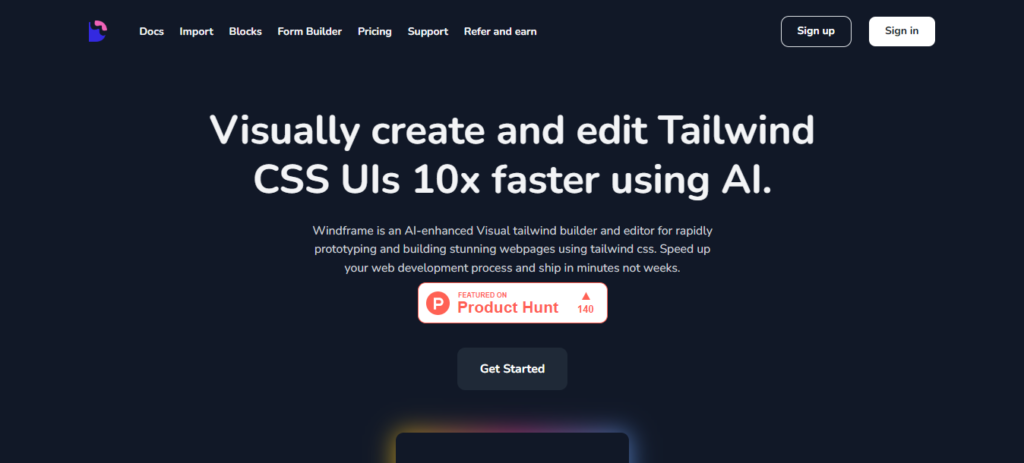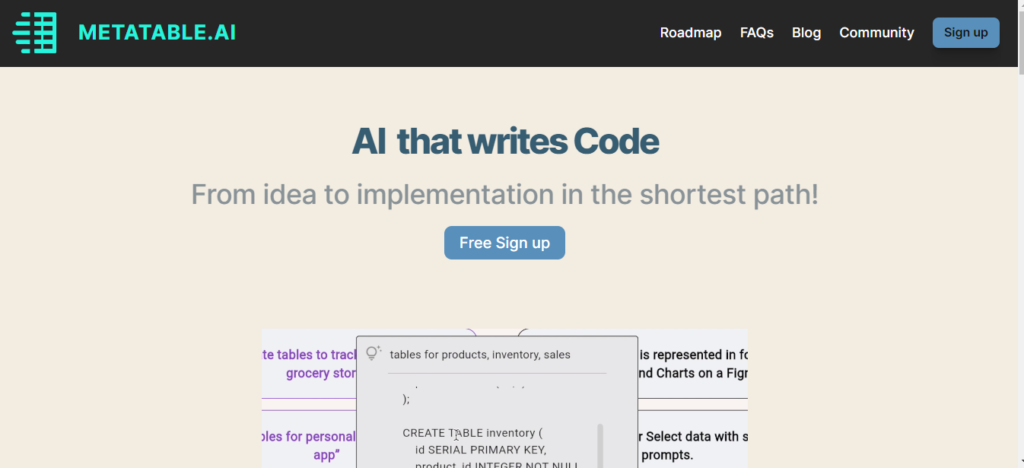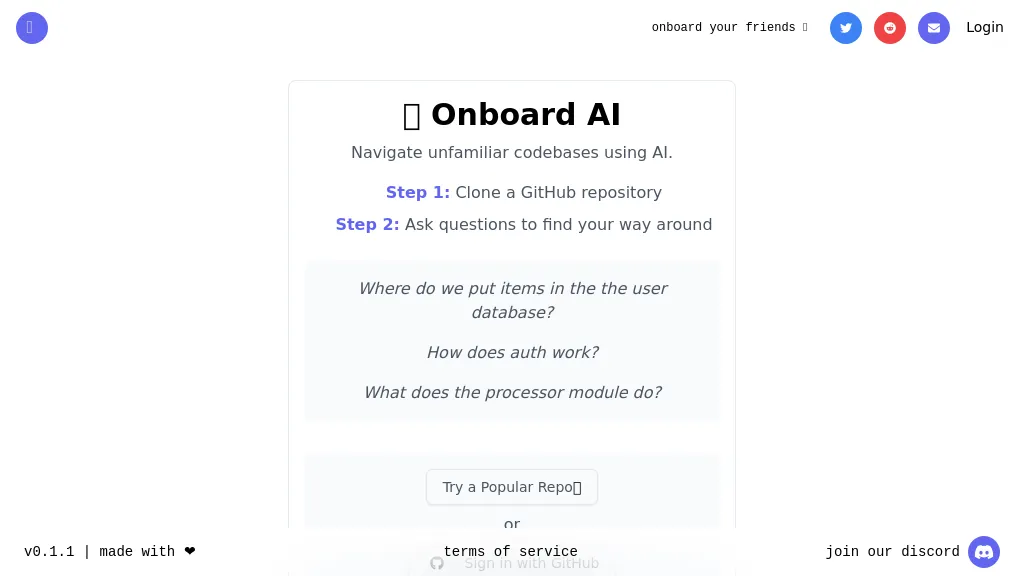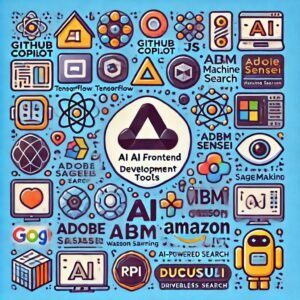The front-end development tool develops the front end of the application. It defines how the application appears to the user. A lot goes on behind the scenes in making a robust, interactive, and attractive user interface. Front-end languages play a significant role in app development. An AI Frontend Development Tool leverages artificial intelligence to streamline and enhance the process of building user interfaces, making development faster and more efficient. This article on Top Front end Languages covers eight such popular languages.
What Is AI Front-end Development Tool?
- Front-end development is a web development that creates the website’s front-end features that are immediately available to the end-user or client.
- A front-end developer is responsible for everything you see, including styling, images, text, alignment, navigation, and colours. It strives to make the user experience as frictionless as possible.
- They also assist with debugging and add to the overall design and look.
- Front-end development’s main aims are responsiveness and performance.
1. RunwayML
Introduction of AI Frontend Development Tool
RunwayML is at the forefront of innovation in AI and creative development. It is a dynamic toolkit that empowers developers to integrate machine learning models seamlessly into their projects. In 2024, AI-driven front-end development will change with RunwayML’s user-friendly interface and extensive library of pre-trained models.

Characteristics of AI Frontend Development Tool
RunwayML is simple and versatile, allowing machine learning model integration without coding. Developers can leverage various models for tasks such as image generation, style transfer, and natural language processing. The platform’s adaptability extends to supporting multiple frameworks and fostering creativity and experimentation in web development.
Pros:
- Ease of Integration: RunwayML excels in its user-friendly approach, making it accessible even to developers with minimal machine learning expertise. The platform simplifies integrating AI models into front-end projects, promoting a smooth development workflow.
- Real-time Interactions: One of the standout features is the real-time ability to interact with AI models. This capability is particularly valuable for dynamic and interactive front-end applications, enhancing the user experience.
- Versatility in Models: RunwayML offers a diverse range of pre-trained models, allowing developers to explore various creative applications. The platform’s versatility caters to a broad spectrum of development needs, from image manipulation to language processing.
Cons:
- Overwhelming Options: The abundance of models and options within RunwayML might be perceived as overwhelming for some users. Navigating the myriad possibilities could pose a challenge, particularly for those new to the platform.
- Curve Variation: Though user-friendly, the learning curve depends on the machine learning task’s complexity. Some tasks are more accessible, and some demand more machine-learning knowledge.
Price in 2024:
As of 2024, RunwayML operates on a subscription-based pricing model, catering to individual users, teams, and enterprises. The pricing structure may include tiered plans, each offering different access levels, features, and usage allowances. Developers can choose a plan that aligns with their project requirements and scalability needs.
RunwayML AI Frontend Development Tool
Finally, in 2024, RunwayML will shape AI-driven front-end development with a powerful toolkit for creative exploration. Its characteristics, pros, and cons illustrate its commitment to simplicity, versatility, and real-time interactions. RunwayML continues to push the limits of AI-infused front-end development as developers seek new methods to include AI.
2. Wizi
Introduction of AI Frontend Development Tool
Wizi, positioned at the cutting edge of technological innovation, emerges as a transformative tool in web development. In 2024, Wizi’s comprehensive AI front-end development tool and revolutionised web application development. Its introduction marks a significant stride in empowering developers to build dynamic and responsive user interfaces more efficiently.

Characteristics of AI Frontend Development Tool
Wizi is characterized by its user-centric design and emphasis on simplifying the front-end development journey. The platform’s drag-and-drop interface lets developers design and prototype web interfaces without coding. With a focus on collaboration, Wizi facilitates seamless communication between designers and developers, promoting a cohesive and iterative development cycle.
Pros:
- Intuitive Interface: Wizi’s drag-and-drop interface lets developers design and structure web interfaces without coding.
- Prototyping: The platform’s rapid prototyping allows developers to improve user interfaces and design ideas in real time, enabling agile development.
- Collaboration Features: Wizi promotes collaboration between designers and developers by providing shared visualization and refining designs. This collaborative approach enhances communication and reduces friction in the development workflow.
Customization
- Limited Customization: Despite its user-friendly approach, Wizi may have limitations in meeting highly customized design requirements. Projects with intricate design specifications may encounter challenges in achieving the desired customization.
- Learning Curve: Wizi simplifies front-end development, but traditional coders may find adjusting the visual, drag-and-drop paradigm difficult.
Price in 2024:
As of 2024, Wizi offers subscription options for developers, teams, and enterprises. Pricing depends on project size, collaborative features, and additional features with each membership tier.
Wizi AI Frontend Development Tool
In conclusion, Wizi emerges as a game-changer in front-end development, embracing a visual and collaborative approach. Its characteristics, pros, and cons shed light on its potential benefits and considerations. Wizi leads web development, offering developers a simple and fast platform to create online interfaces.
3. Aigur
Introduction of AI Frontend Development Tool
In 2024, revolutionary tech company Aigur launched a power evolutionizer that revolutionizes web creation with artificial intelligence (AI). Aigur is a complete solution that lets developers and enterprises integrate AI into online apps. Its debut improves online platform functioning and user experience in an age of intelligent features.

Characteristics of AI Frontend Development Tool
Aigur distinguishes itself through its robust characteristics, combining versatility and ease of use. It is characterized by its adaptability to various AI models and frameworks. Aigur simplifies the complex task of AI integration for developers. The platform uses real-time data processing and analysis to help apps employ AI for better decision-making and user interactions.
Pros:
- Versatility: Aigur’s adaptability lets developers easily incorporate many AI models into web apps, ensuring they can choose the most suitable AI solution.
- Data Proceprioritizesr prioritizes real-time prioritizes and analysis, enabling web apps to use AI for immediate decision-making. This contributes to a more dynamic and responsive user experience.
- Friendly Interface: Aigur’s user-friendly interface makes AI integration easy for developers of all levels. The platform’s intuitive design promotes a smoother learning curve for those new to AI development.
Cons:
- Learning Curve: Despite its user-friendly interface, Aigur may pose a learning curve for developers new to AI integration. Possessing the full potential of the platform’s features might require some initial investment in learning and training.
- Cost Implications: Depending on the pricing model adopted, Aigur’s comprehensive features and capabilities might incur associated costs. Developers and businesses need to consider the pricing structure of their budgets and project requirements.
Price in 2024:
As of 2024, Aigur offers subscription-based subscriptions for developers, teams, and enterprises. The scale of AI integration, model complexity, and support and features in each subscription tier will influence pricing.
Aigur AI Frontend Development Tool
In conclusion, Aigur is a vital tool in converging AI and web development, providing a flexible and easy way to integrate intelligence into apps. Features, pros, and drawbacks highlight its possible benefits and considerations. As AI-driven web apps evolve, Aigur can help deorganizationsorganizations create more intelligent, responsive, and feature-rich digital experiences.
4. Windframe
Introduction of AI Frontend Development Tool
They are introducing Windframe, a trailblazing solution in the dynamic realm of web development, poised to redefine the landscape in 2024. Windframe is an innovative framework that helps developers build efficient, scalable, and beautiful web apps. As the digital winds of change blow through the development industry, Windframe offers a new viewpoint on simplified, feature-rich, and future-ready web development.

Characteristics of AI Frontend Development Tool
Windframe distinguishes itself through a host of characteristics that align with the evolving needs of modern web development. The framework is known for its adaptability, seamlessly accommodating various development stacks and technologies. With a robust emphasis onoptimization optimization, Windframe optimization applications meet and exceed user expectations regarding speed, responsiveness, and overall user experience.
Pros:
- Adaptability to Diverse Stacks: One of Windframe’s standout features is its adaptability to diverse development stacks. Developers can leverage their preferred technologies, fostering flexibility and catering to various project requirements.
- Performization Optimization prioritises efficient optimization code that anticipates the demands of modern, data-intensive web applications, ensuring optimal performance across various use cases.
- Scalability-Oriented Design: Scalability is at the heart of Windframe’s design philosophy. The framework helps developers build scalable web apps that use tools and patterns to grow with user bases.
Cons:
- Potential Learning Curve: While Windframe is designed for adaptability, developers unfamiliar with its conventions may face a learning curve during the initial phases of adoption. Familiarity with the framework’s intricacies may be required for optimal utilization.
- Community Utilization Maturity: Depending on the current stage of development, Windframe’s community and documentation may be evolving. Developers may encounter challenges finding comprehensive resources, which is expected to improve over time.
Price in 2024:
As of 2024, Windframe operates on an open-source model, providing developers with the framework free of charge. The framework’s commitment to an open-source philosophy contributes to its accessibility and encourages community collaboration.
Windframe AI Frontend Development Tool
In conclusion, Windframe emerges as a breath of fresh air in the world of web development, offering adaptability, performance, and scalability. Its characteristics, pros, and cons shed light on its potential benefits and considerations. As developers seek a framework that not only meets the demands of the present but anticipates future challenges, Windframe stands ready to be a pivotal ally in crafting the next generation of web applications.
5. Coframe
Introduction of AI Frontend Development Tool
In the ever-evolving landscape of web development, Coframe emerges as a beacon of innovation, redefining the paradigm of backend development in 2024. Coframe is not merely a tool; it’s a comprehensive platform designed to automate critical aspects of the development lifecycle, promising efficiency gains and a streamlined development experience. As the digital terrain undergoes continuous transformation, Coframe stands as a testament to the power of automation and efficiency in crafting robust and scalable backend infrastructures.

Characteristics of Frontend Development Tool
Characterized by its common-to-end automation, Coframe streamlines backend infrastructure setup and API development. The platform is designed to seamlessly adapt to various frameworks and technologies, providing developers with flexibility in their choice of tools. With a robust emphasis onoptimization optimization, Coframe optimization scalability challenges, laying a solid foundation for applications with evolving user demands.
Pros:
- Time and Resource Savings: Firstly, coframe delivers significant time and resource savings by automating repetitive tasks, allowing developers to allocate more time to strategic aspects of application development.
- Consistent Code Quality: Secondly, the platform’s automated processes contribute to maintaining consistent code quality, reducing the likelihood of errors, and ensuring adherence to best practices.
- Scalability at the Core: Thirdly, coframe’s focus on scalability ensures that the generated backend code is ready to handle increased workloads, providing a robust foundation for applications with dynamic user deCustomizands.
Cons:
- Customization Limitations: Customization efficiency, Coframe may have limitations in customized requirements, and customized generation may not offer the same level of flexibility as manual coding.
- Learning Curve: Developers accustomed to traditional backend development workflows may encounter a learning curve when transitioning to Coframe and adapting to its automated processes.
Price in 2024:
As of 2024, Coframe operates on a subscription-based pricing model. The pricing structure is likely to consider factors such as the scale of projects and the customization of additional features in different subscription plans.
Conclusion:
In conclusion, Coframe emerges as a trailblazer in backend development, introducing a holistic approach to automation and efficiency. Its characteristics, pros, and cons highlight its potential benefits and considerations. Moreover, coframe stands at the forefront as the software development landscape evolves, presenting a compelling option for developers seeking a streamlined and automated backend development experience.
6. Lightly.ai
Introduction of AI Frontend Development Tool
In data annotation and machine learning, Lightly is a versatile and innovative solution, offering a comprehensive platform to streamline preparing and enriching datasets. Moreover, as the demand for high-quality annotated data surges in 2024, Lightly will become a beacon of efficiency and precision. Furthermore, this tool is not merely a facilitator; rather, it’s a transformative force that will revolutionize the landscape of machine learning applications.

Characteristics of Frontend Development Tool
Characterized by its user-friendly interface, Lightly brings a new dimension to data annotation. The platform supports various annotation types, allowing users to label images, videos, and other data formats easily. With advanced features such as active learning, Lightly adapts to user preferences, making the annotation process more innovative and more efficient over time. Furthermore, the platform’s versatility extends to compatibility with popular machine learning frameworks, fostering seamless integration into the broader development workflow.
Pros:
- User-Friendly Interface: Firstly, lightly’s user-friendly interface makes data annotation accessible to a broader audience, reducing the learning curve and empowering users with varying levels of expertise.
- Versatile Annotation Support: Secondly, the platform supports various annotation types, catering to different data formats and use cases. This versatility ensures users can tackle diverse annotation challenges within a unified environment.
- Active Learning Capabilities: Thirdly, this smart functionality lightly leverages active learning, adapting to user preferences and continually improving the annotation process. Optimizes efficiency and optimizes quality.
Cons:
- Potential Complexity for Beginners: While designed for ease of use, users new to data annotation or machine learning may initially find some features or concepts complex. Adequate onboarding resources and tutorials can mitigate this challenge.
- Dependency on Connectivity: Furthermore, as a cloud-based platform, it lightly relies on internet connectivity. Users in environments with limited or unreliable internet access may face challenges in seamlessly accessing the platform.
Price in 2024:
As of 2024, Lightly operates on a subscription-based pricing model. The pricing structure likely considers factors such as the volume of annotations, storage requirements, and the level of support provided in different subscription plans.
Conclusion:
In conclusion, Lightly emerges as a pivotal tool in the data annotation landscape, offering a harmonious blend of usability and advanced features. Its characteristics, pros, and cons underscore its potential benefits and considerations. Moreover, as the need for high-quality annotated data continues to drive advancements in machine learning, Lightly stands ready to be a cornerstone in the journey toward more accurate and efficient model training.
7. Unfetch
Introduction of AI Frontend Development
Unfetch, a prominent player in the front-end development landscape, enters the stage as a powerful and lightweight library designed to simplify the HTTP request process. As of 2024, Unfetch is a testament to the evolution of web development tools, offering developers a streamlined and efficient solution for handling asynchronous communication between the client and server. Moreover, Unfetch is not merely a library; rather, it’s a catalyst for enhancing the efficiency and responsiveness of web applications.

Characteristics of Frontend Development
Characterized by its simple design, Unfetch aims to provide a straightforward, developer-friendly interface for making HTTP requests. Furthermore, the library boasts a small footprint, contributing to faster load times and optimal performance. With a focus on compatibility, Unfetch seamlessly integrates with modern JavaScript frameworks and libraries, therefore offering a versatile solution for a wide range of development scenarios.
Pros:
- Lightweight and Fast: Firstly, unfetch’s lightweight nature contributes to faster load times and responsive user experience. Its streamlined design ensures that only essential features are optimised, optimizing perfoptimize.
- Veoptimizingmpatibility: Secondly, the library is designed to be adaptable, seamlessly integrating with various JavaScript frameworks and libraries. This compatibility enhances its usability across different development environments.
- Simplified Syntax: Thirdly, unfetch simplifies the syntax for making HTTP requests, reducing the boilerplate code typically associated with asynchronous communication. This simplicity leads to cleaner and more maintainable code.
Cons:
- Limited Feature Set: Unfetch may lack certain advanced features in more comprehensive HTTP request libraries due to its minimalistic design. Projects with specific requirements may need to supplement Unfetch with additional tools.
- Community Support Variation: Moreover, depending on the project’s scale and complexity, users may find variations in community support. Smaller or less active communities may lead to challenges in finding extensive resources and documentation.
Price in 2024:
As of 2024, Unfetch operates on an open-source model, allowing developers to use the library free of charge. This encourages community collaboration and fosters a culture of knowledge sharing.
Conclusion:
In conclusion, Unfetch is a beacon of simplicity and efficiency in front-end development. Its characteristics, pros, and cons highlight its potential benefits and considerations. Moreover, as developers prioritize speed and versatility of use, Unfetch stands ready to be a valuable asset in the arsenal of tools shaping the future of web development.
8. Metatable.ai
Introduction of AI Frontend Development Tool
Metatable.ai emerges as a cutting-edge solution in the dynamic landscape of data management and analysis, offering a sophisticated platform designed to streamline and elevate the data preparation process. In 2024, as data becomes increasingly integral to decision-making, Metatable.ai enters the scene as a pivotal tool for organizations to unlock the organizational potential of their data. Moreover, beyond being a tool, Metatable.ai is a catalyst for efficient data handling, revolutionizing the way organizations extract insights from their datasets.

Characteristics of AI Frontend Development Tool
Characterized by its intuitive interface and advanced analytics capabilities, Metatable.ai distinctly sets itself apart as a comprehensive data management solution. Moreover, the platform facilitates seamless collaboration between data scientists, analysts, and business users, promoting a unified data exploration and analysis approach. With features like auto-discovery of data patterns and integrated machine learning, furthermore, Metatable.ai empowers users to harness the power of their data without extensive manual intervention.
Pros:
- Intuitive User Interface: Firstly, Metatable.ai prides itself on its intuitive user interface, which makes data exploration and analysis accessible to users with varying technical expertise. This characteristic promotes a user-friendly experience and reduces the learning curve.
- Advanced Analytics Capabilities: Secondly, the platform offers advanced analytics features and fundamental data management. In addition, auto-discovery of data patterns and integrated machine-learning tools enrich the analytical process, providing users with actionable insights.
- Collaborative Environment: Thirdly, Metatable.ai fosters a collaborative environment, enabling seamless interaction between stakeholders in data analysis. This collaborative approach contributes to more informed decision-making.
Cons:
- Advanced Features: Users new to advanced analytics features or machine learning within Metatable.ai may initially find some features complex. Adequate training resources and support can mitigate this challenge.
- Dependency on Data Quality: Furthermore, like any data analysis tool, Metatable.ai’s effectiveness relies on the quality of input data. Users must ensure their datasets are clean and well-prepared for optimal results.
Price in 2024:
As of 2024, Metatable.ai operates on a subscription-based pricing model, offering different plans tailored to individual users, teams, and enterprise-level requirements. The pricing structure will likely consider factors such as the volume of data processed, advanced feature access, and the level of support provided in each subscription tier.
Conclusion:
In conclusion, Metatable.ai is a beacon of data management and analysis innovation. Its characteristics, pros, and cons underscore its potential benefits and consideration. As organizations navigate the complex landscape of data-driven decision-making, Metatable.ai, therefore, stands ready to be a key enabler, thereby providing a robust platform for exploring, understanding, and deriving value from diverse datasets.
9. AI Inferkit
Introduction of AI Frontend Development Tool
AI Inferkit emerges as a transformative force in artificial intelligence-driven content generation. In 2024, where content creation is paramount, AI Inferkit steps onto the stage as a sophisticated language model designed to empower writers, developers, and content creators. More than just a tool, AI Inferkit represents a leap forward in natural language processing, offering a versatile platform for generating high-quality, contextually relevant textual content.

Characteristics of AI Frontend Development Tool
Characterized by its states, AI Inferkit effectively employs advanced algorithms to understand context, tone, and language nuances. Moreover, the platform supports a variety of use cases, from creative writing to code generation, making it a versatile asset for diverse applications. With an intuitive and user-friendly interface, AI Inferkit furthermore strives to bridge the gap between complex language models and user accessibility, thus allowing individuals with varying levels of expertise to leverage its power.
Pros:
- Contextually-Aware Content: Firstly, AI Inferkit excels at generating contextually aware content and understanding the intricacies of language to produce coherent and relevant text.
- Versatile Use Cases: Secondly, the platform’s versatility shines through in its ability to cater to various use cases, including creative writing, content creation, and even code generation, making it adaptable to diverse needs.
- User-Friendly Interface: Thirdly, its user-friendly interface prioritizes user accessibiprioritizesing that seasoned writers and those new to natural language processing can utilize its features efficiently
Cons:
- Potential for Bias: Moreover, like any language model, AI Inferkit may exhibit biases in the training data, necessitating careful consideration and review of generated content for potential biases.
- Learning Curve for Advanced Use: Furthermore, users delving into advanced customization options may experience an emerging customization curve. Adequate documentation and support resources can mitigate this challenge.
Price in 2024:
As of 2024, AI Inferkit operates on a subscription-based pricing model. Moreover, the pricing structure likely considers usage volume, advanced feature access, and support offerings within different subscription tiers.
Conclusion:
In conclusion, AI Inferkit is a game-changer in the content generation landscape, leveraging advanced language models for contextually rich textual output. Its characteristics, pros, and cons underscore its potential benefits and considerations. Moreover, as content creators seek innovative tools to enhance productivity and creativity, AI Inferkit emerges as a valuable companion, contributing to the evolution of natural language processing in the digital era.
10. Second Home
Introduction of AI Frontend Development Tool
Stepping into modern coworking spaces, Second Home, therefore, offers a refreshing perspective on the work environment, blending innovation, community, and sustainability. In the context of 2024, as workspace dynamics continue to evolve, Second Home thus presents itself as a physical space and a holistic solution for fostering creativity, collaboration, and work-life balance. Moreover, beyond providing desks and chairs, Second Home furthermore aims to create a thriving ecosystem where professionals can flourish and ideas can blossom.

Characteristics of AI Frontend Development Tool
Characterized by its thought spaces, Second Home distinctly sets itself apart with architectural innovation and a commitment to sustainable practices. Moreover, the coworking environment is crafted to inspire creativity and features vibrant and dynamic settings. Beyond aesthetics, Second Home furthermore fosters a sense of community through curated events, networking opportunities, and shared resources. Additionally, the spaces are equipped with state-of-the-art technology, facilitating seamless collaboration and productivity.
Pros:
- Innovative Design: Firstly, Second Home is characterized by creative, aesthetically pleasing design, which creates an inspiring work atmosphere that enhances productivity.
- Community Building: Secondly, the platform fosters community through events, networking opportunities, and shared resources. This community-centric approach contributes to a supportive and collaborative work environment.
- Sustainability Focus: Thirdly, Second Home is committed to sustainability and incorporates eco-friendly practices and design elements, aligning with the growing emphasis on environmental responsibility.
Cons:
- Cost Considerations: Depending on location and amenities, the cost of membership at Second Home may be higher than that of traditional coworking spaces. The premium experience comes with a corresponding financial investment.
- Space Availability: In high-demand locations, securing dedicated space at Second Home might be subject to availability constraints. This could be a consideration for businesses with specific spatial requirements.
Price in 2024:
As of 2024, Second Home operates on a membership-based pricing model. The pricing structure considers factors such as the type of membership, access to amenities, and the location of the workspace. Prices may vary across different membership tiers.
Conclusion:
In conclusion, Second Home stands as a beacon of innovation in the coworking space landscape. Its characteristics, pros, and cons provide insights into its potential benefits and considerations. As professionals seek not just a workplace place but an ecosystem that nurtures creativity and collaboration, Second Home positions itself as a holistic solution, redefining the conventional notion of a workplace.
11. Onboard AI
Introduction of AI Frontend Development Tool
Onboard AI steps into the forefront of HR technology, offering a comprehensive revolution to the employee onboarding experience. Organizational efficiency and talent retention are paramount, so Onboard AI positions itself as a strategic partner for businesses seeking to streamline and enhance the onboarding process. Far beyond a conventional onboarding tool, Onboard AI, furthermore, leverages artificial intelligence to create personalized and efficient experiences for employees and employers.

Characteristics of AI Frontend Development Tool
Characterized by its intel, Onboard AI effectively transforms the onboarding journey into a personalized process. Furthermore, it is utilized to adapt to individual employee needs, ensuring a tailored onboarding experience. With features such as automated document processing, task assignment, and real-time progress tracking, Onboard AI sets itself apart as a sophisticated solution for modern HR challenges.
Pros:
- Personalized Onboarding: Firstly, personalized onboarding is a personal experience that customises machine learning to adapt to each employee’s role, preferences, and learning style.
- Efficient Document Processing: Secondly, the platform’s automated document processing capabilities streamline paperwork, reducing administrative burdens and ensuring compliance with documentation requirements.
- Real-time Progress Tracking: Thirdly, onboard AI facilitates real-time tracking of onboarding progress, allowing HR teams to monitor and manage the onboarding journey efficiently.
Cons:
- Integration Complexity: Firstly, integrating Onboard AI may pose complexity depending on existing HR systems and infrastructure. Ensuring seamless integration with other HR tools may require additional technical considerations.
- Potential Learning Curve: HR teams unfamiliar with AI-driven onboarding tools may face a learning curve when understanding the platform’s features. Adequate training and support resources can address this challenge.
Price in 2024:
As of 2024, Onboard AI operates on a subscription-based pricing model. The pricing structure will likely consider factors such as size, the organisation, and the support required in each subscription tier.
Conclusion:
In conclusion, Onboard AI emerges as a game-changer in employee onboarding, combining intelligence and automation for a tailored and efficient experience. Its characteristics, pros, and cons shed light on its potential benefits and considerations. Moreover, as businesses strive for a competitive edge in talent acquisition and retention, Onboard AI stands as a valuable ally, offering a forward-looking solution to the ever-evolving challenges of the HR landscape.
12. Jetbrains IDE Plugin
Introduction of AI Frontend Development Tool
The JetBrains IDE Plugin, an integral part of the JetBrains suite, emerges as a pivotal tool in integrated development environments (IDEs). In the context of 2024, where coding efficiency and developer productivity are paramount, this plugin thus takes centre stage as a feature-rich companion to JetBrains IDEs, thereby promising to enhance the development experience. More than just an add-on, the JetBrains IDE Plugin encapsulates a suite of capabilities to streamline coding workflows and foster a conducive environment for software development.

Characteristics of AI Frontend Development Tool
Its seamless integration with JetBrains IDEs characterizes it. Furthermore, it brings a variety of characteristics that elevate the development process. With intelligent code assistance, robust version control integration, and many code analysis tools, the JetBrains IDE Plugin therefore, empowers developers to write clean, efficient code. Its support for various programming languages and frameworks ensures versatility, thus making it a go-to choice for diverse development projects.
Pros:
- Intelligent Code Assistance: The plugin provides intelligent code assistance, offering context-aware suggestions, auto-completion, and error detection, significantly boosting developer efficiency.
- Robust Version Control Integration: Furthermore, JetBrains IDE Plugin seamlessly integrates with version control systems, facilitating smooth collaboration and efficient management of code repositories.
- Extensive Code Analysis Tools: Moreover, developers benefit from a comprehensive set of code analysis tools that help them identify potential issues, ensure code quality, and adhere to best practices.
Cons:
- Resource Intensiveness: Depending on the size and complexity of projects, the JetBrains IDE Plugin may consequently consume significant system resources, potentially affecting the performance of less powerful machines.
- Learning Curve for New Users: For developers new to JetBrains IDEs or the plugin, there might be an initial learning curve when navigating and harnessing the full spectrum of features. However, documentation and tutorials can mitigate this.
Price in 2024:
As of 2024, JetBrains IDE Plugin typically operates on a subscription-based model. The pricing structure will likely vary based on factors such as the specific JetBrains IDE in use, the type of subscription (individual, business, or enterprise), and additional features included in different subscription tiers.
Conclusion:
In conclusion, the JetBrains IDE Plugin is an indispensable tool in the JetBrains ecosystem, offering developers a wealth of features. Its characteristics, pros, and cons illustrate its potential benefits and considerations. Moreover, as developers seek a refined and efficient coding experience, the JetBrains IDE Plugin, therefore, remains a cornerstone in fostering productivity and code quality within the dynamic software development landscape.







